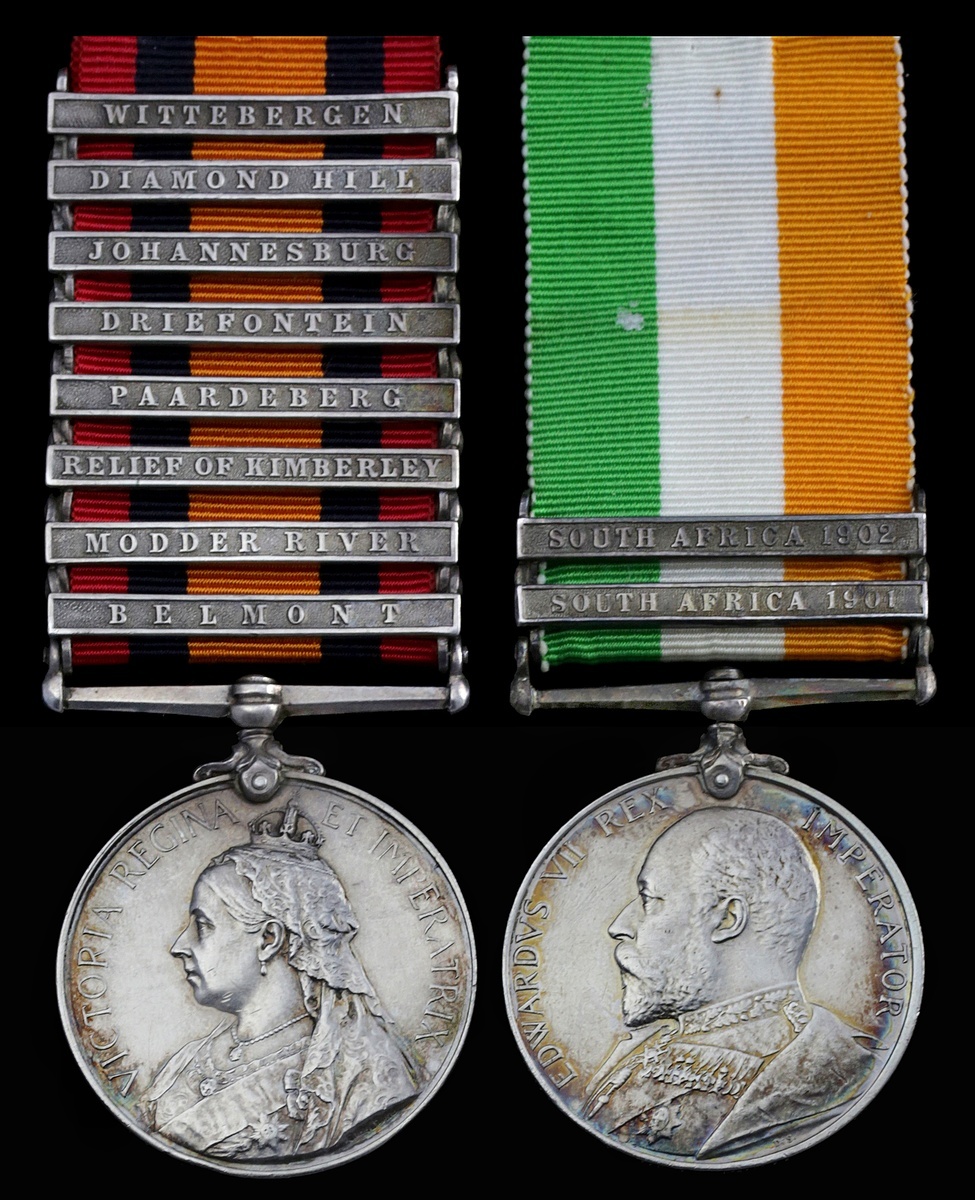
Auction: 19002 - Orders, Decorations and Medals
Lot: 756
(x) Rimington's Guides
Rimington's Guides were an elite unit, some 150 strong, raised at the outbreak of the war and comprised of experienced colonials who knew the country and shot superbly. Stirling records that, 'As far as numbers go they were not strong, but for quality, officers and men could not be surpassed' (The Colonials in South Africa, refers). This aura of elitism was reinforced by the name commonly used by the other troops in South Africa, Rimington's 'Tigers', owing to the band of leopard skin they wore around their slouch hats.
Rimington's 'Tigers' did more fighting in the early weeks of the war than any other unit. After undertaking an expedition to Prieska in November 1899 to quell a potential rebellion, they joined Lord Methuen's force and scouted the ground and conducted fighting patrols prior to the battle of Belmont on 23 November. 'The corps was present at that battle on the extreme right; at Enslin or Graspan on the 25th, again on the right; at Modder River on the 28th, on the left, being among the first troops to cross the river; at Magersfontein on 10th and 11th December, again on the left' (Stirling, refers). In January 1900, De la Porte's squadron fought at Colesberg and Kleinfontein before they were brought up to the Modder River to play a major mounted role in Lord Roberts' push towards Pretoria. They accompanied General French in the rush to Kimberley. Rimington's 'Tigers' marched to Bloemfontein, fought at Paardeberg, Poplar Grove and Driefontein. They were involved in the action at Sanna's Post, the capture of Brandfort, the battles of Doornkop, Diamond Hill and the Brandwater Basin, the occupations of Pretoria and Johannesburg. In the early stages of the guerrilla war they were often attached to columns and scouts and guides.
In early 1901, the 'Tigers' were paid off after Major Rimington was promoted to command a column. One of the squadron commanders, Major Damant, was requested by Lord Kitchener to form a successor unit. It was named Damant's Horse. By one of those odd quirks of fate that sometimes occur, the medal rolls of Rimington's Guides and Damant's Horse were combined under the title Damant's Horse. When the Medals were issued the original 'Tigers' found that all the medals were named to Damant's Horse and not, where applicable, Rimington's Guides. Given the history and corps d'esprit of 'Mike' Rimington's 'Tigers' it is no small surprise that many of them, De la Porte - see below - included, had 'Damant's Horse' erased from their Medal and 'Rimington's Guides' engraved in its stead.
A rare Boer War pair awarded to Lieutenant R. De La Porte, Field Intelligence Department, late Rimington's Guides, the recipient of the maximum possible eight battle and two date clasps, who was recommended for the D.S.O. and mentioned in despatches for gallantry by Lord Kitchener
Queen's South Africa 1899-1902, 8 clasps, Belmont, Modder River, Relief of Kimberley, Paardeberg, Driefontein, Johannesburg, Diamond Hill, Wittebergen (44 Sjt:-Maj: R. De La Porte. Rimington's Guides); King's South Africa 1901-02, 2 clasps, South Africa 1901, South Africa 1902 (Lieut: C. R. De La Porte. F.I.D.), the first with corrected unit, generally very fine and rare (2)
Cecil Richard De La Porte attested for Major Michael F. Rimington's Corps of Guides in October 1899, aged 25 years, stating he was 'used to using explosives' and able to speak 'a little' Dutch.
Advanced to Corporal in January 1900 and to Sergeant in September 1900, he was wounded in action on the 25th of the latter month at Kaffir Kop - a farmstead in the Western Cape commanding high ground. Discharged from Rimington's Guides at Cape Town on 22 May 1901, having attained the rank of Sergeant-Major, De La Porte subsequently gained a commission in the Field Intelligence Department.
In June 1902 Lieutenant De La Porte was recommended for the Distinguished Service Order for the following deeds but, instead, received a mentioned in despatches (London Gazette 29 July 1902, refers):
'For general brave, good and reliable work in all ranks of Rimington's Guides, and afterwards as Intelligence Agent and Intelligence Officer, all through the War, and particularly on 20 November 1901, when, by his quickness and initiative, Commandant Buys, who was being taken away wounded in a cape-cart from the fight near Villiersdorp, was taken prisoner; and on the night of 23 February 1901, when he was with Colonel Cox, N.S.W.M.R., in the action on the Hol Spruit, and assisted him in checking the Boers who broke through the picquet-line and prevented them from further rolling up the picquets. He was severely wounded in attempting to capture Boers in October 1900' (War Office records, refer).
The recommendation was additionally annotated by W. F. Rimington, 'I concur with the above fully'.
Hostilities over, De La Porte took employment in 1903 with the Sabi Game Reserve as a Ranger. Since 1926 the Reserve has been more commonly known as the Kruger National Park. Working alongside Warden James Stevenson-Hamilton, formerly of the 6th Inniskilling Dragoons, De La Porte was heavily engaged in stopping the movement of cattle through the Park and halting prospecting for coal and precious minerals. He administered the Reserve during the Great War and protected it from agricultural cultivation, although the lack of manpower and weak administration of his successor took its toll; sold with copied research and roll.
Reference source:
http://www.krugerpark.co.za/first-warden-stevenson-hamilton.html
Subject to 5% tax on Hammer Price in addition to 20% VAT on Buyer’s Premium.
Sold for
£1,500
Starting price
£550




